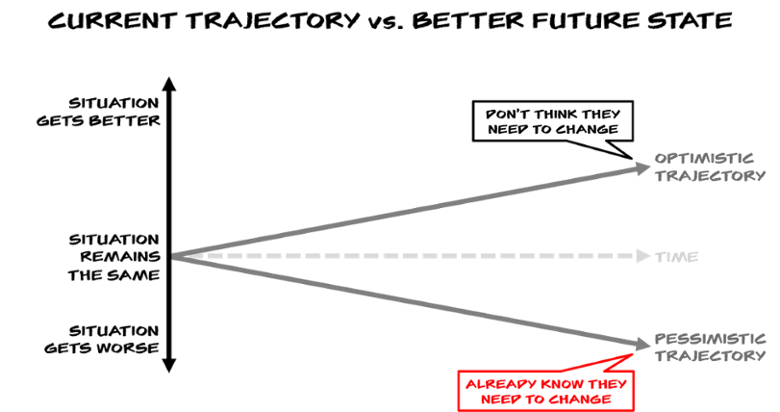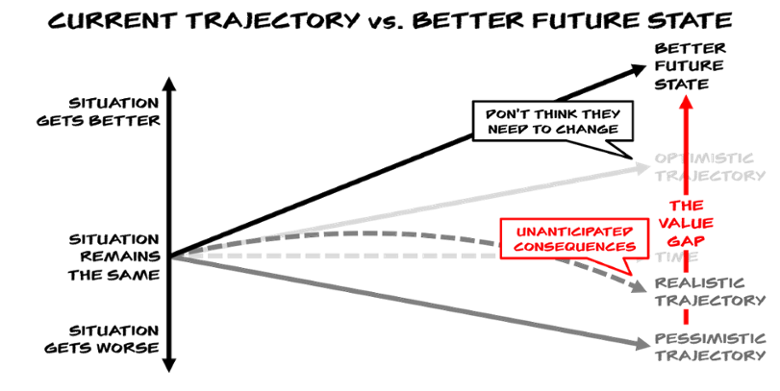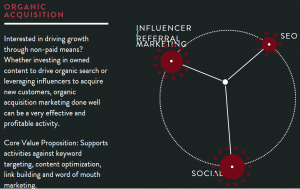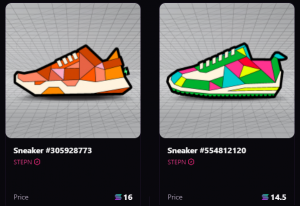— June 28, 2017
 Most of today’s most popular B2B sales methodologies – including Value Selling, Challenger®, Solution Selling, Consultative Selling, SPIN® selling and many more – recommend that we always take the time to diagnose our prospect’s current pain points before we seek to propose our solution.
Most of today’s most popular B2B sales methodologies – including Value Selling, Challenger®, Solution Selling, Consultative Selling, SPIN® selling and many more – recommend that we always take the time to diagnose our prospect’s current pain points before we seek to propose our solution.
These techniques are even more effective when we manage to amplify the pain of their current situation or help the prospect to acknowledge previously unrecognized or undervalued needs that we are particularly effective at addressing.
But simply seeking to diagnose their current situation seems like an inadequate strategy compared with helping them see the future consequences of pursuing their current trajectory as opposed to what they might be able to achieve if they were willing to change their behavior…
I’ve shared my thoughts about the concept of the value gap in previous articles. Now I’d like to focus my attention on a key aspect of the value gap – the need to establish the greatest possible contrast between our customer’s current trajectory and a better future state that they could be capable of reaching with our help.
When we ask our customers to look forward to the future, some will believe that they are on a positive trajectory. Others may already recognize that they have issues that they know they need to address, and acknowledge that if they fail to deal with them they will find themselves on a negative trajectory. And many (perhaps the majority) will probably regard themselves as being “somewhere in between”.

We might think that those customers who already recognize that they have issues that they need to deal with would represent our best short-term prospects. But that depends a great deal on the point at which they involved us in the conversation.
If we’ve been there from the start – even better, if we’ve been the catalyst that caused them to recognize the need to change in the first place – we start with some significant advantages.
But if we’ve only been able to engage at a late stage in their decision journey – after they have already started to form a view about what an ideal solution might look like – we can find ourselves at a significant disadvantage, because it’s likely that our competitors have already influenced their thinking.
And even if the customer currently believes they are on a positive trajectory, they may well be wrong – because if organizations fail to recognize or react to the idea that the world is changing, staying with the status quo is almost certain to expose them to growing risk. If with the benefit of our collective experience we can credibly claim to know better, then it’s up to us to challenge their perceptions.

Whether the customer believes they are currently on a positive or negative trajectory, our goal is to persuade them that there is a significant and growing value gap between their current trajectory and a significantly better future state that they can reach with our help.
SMALL VALUE GAP = LITTLE LIKELIHOOD OF ACTION
Or, if we can’t establish that significant value gap, we may want to reconsider whether the customer has sufficient motivation to change and whether we should invest a great deal of time in pursuing what may be a poorly qualified opportunity.
The value gap is all about contrasting the negative implications of pursuing their current trajectory with the positive outcomes they can expect from changing their behavior. If there is little or no contrast, there is likely to be little or no real motivation to take decisive action.
Even when they adopt a “solution selling” mindset, many salespeople – and many marketing campaigns – tend to leap straight from a targeted problem to the benefits of their solution, but this is a big mistake and serves to suppress the customer’s motivation to change.
LOSS AVERSION THERAPY
In his ground-breaking work on loss aversion, the Nobel-winning behavioural economist Dan Kahneman showed that people (and the organisations they work for) are twice as likely to be willing to spend to avoid a loss as they are to invest to achieve a gain.
So if our messages are all about the potential of future gain, and are not also contrasted with the probability of increasing pain should the customer follow their current trajectory and stick with the status quo, we’re undermining more than half of our potential ability to motivate them to take action.
When establishing and amplifying our customer’s value gap, we need to go beyond the obvious aspects of their current situation and help them to recognise and acknowledge the unexpected, undervalued and unrecognised negative consequences of staying on their current path and sticking with the status quo.
A CHANGING WORLD
We need to paint a picture of a changing world in which trends over which they may have little control are creating an environment in the organisations that are able to adapt will emerge as the winners and those that don’t end up as as losers. We need to help our customers to recognise and react to their emerging future reality.
And we need to persuade them that the longer they wait, the worse the value gap is likely to become. There is no question: contrast drives urgency – and complacency only serves to store up problems for the future.
So: what are your marketers and sales people doing to help your prospective customers recognise the value gap between their current trajectory and a better future state? And how are they positioning your unique enablers as the customer’s best opportunity to bridge the gap?
THE SALES VALUE GAP
I’m writing this article as we enter the last few days of the first half of the sales year. I’m prepared to bet that many of the opportunities that are currently being confidently forecasted but which end up failing to close suffer that fate because the customer didn’t see a big enough value gap and decided to stick with the status quo.
It’s a pattern that will be repeated in sales pipeline reviews around the world. Are you prepared to let that happen to your sales organization? And if – as might be the case – it’s too late to do much to change matters before the end of the current quarter, what are you prepared to prevent the same pattern being repeated next quarter?
Because, just like your customers, your sales organization almost certainly has a value gap too.
Business & Finance Articles on Business 2 Community
(65)
Report Post








